
23 minute read
Legal
Green financing and green technology in rail
The Great British rail industry is on the verge of a technological revolution. In this article Kulraj Badhesha and Tammy Samuel explore some of the targets that have sparked the upheaval, the green technologies being proposed to instigate the change and potential green financing options which could be used to fund the transformation

Kulraj Badhesha

Tammy Samuel
The Paris Climate Agreement introduced in 2015 was the first universal, legally binding global climate change agreement. The UK ratified the Paris Agreement in 2016, agreeing to its aim to reduce gas emissions by at least 40 per cent by 2030, compared to 1990 emissions levels. Based on CO₂ emissions rates, rail is one of the greenest modes of transport available. It contributes less than 2.5 per cent of total transport emissions in the UK and about 0.6 per cent of the UK’s total emissions. The rail industry will therefore be instrumental in delivering the climate change objectives set out in the Paris Climate Agreement.
But the rail industry cannot simply rest on its laurels. This is particularly the case given the significance of the climate change challenge and the pace of technological change. Major changes, on an industry-wide basis, are still needed.
Trains in the UK still rely predominantly on diesel traction for their power, and railway traction accounts for the greatest proportion of emissions within rail. An estimated 62 per cent of the rail network is currently diesel-powered.
In June 2019, the UK Government legislated to end its contribution to climate change by 2050: a target which requires the UK to become entirely carbon neutral less than thirty years from now. The Department for Transport has further challenged the rail industry to remove all diesel-only trains from the network by 2040. Transport Scotland has further thrown down the gauntlet, setting a more ambitious challenge to decarbonise domestic passenger rail services in Scotland by 2035.
How will the rail industry achieve these ambitious targets? The Rail Industry Decarbonisation Taskforce reported that an estimated 3,000-3,300 diesel passenger vehicles will need to be replaced, re-engined or converted to achieve a carbon neutral railway.
The industry is already moving to modify existing rolling stock in order to reduce emissions. ROSCOs in particular are taking a proactive approach, not least to preserve the value of their rolling stock.
We explored some of the specific examples of new technological solutions being put into action by the industry in more depth in a previous article, in last month’s issue of Rail Professional. Broadly speaking, the focus of the ROSCOs to date has been in modifying existing diesel fleets through retrofitting battery packs. There have also been examples of the use of hydrogen fuel cell technology in the industry.
These new technologies provide huge potential for cleaner alternatives to diesel. The industry has already begun to invest in change. However, much of the technology is still in its relative infancy. For example, longer distance journeys on battery powered trains are not yet feasible. Hydrogen infrastructure is not widely available at depots and stations. Investment so far has therefore been piecemeal rather than widespread. It is also not clear that modification of existing fleets alone will be sufficient in achieving the challenging targets faced by the industry.
Electric powered trains are currently the only alternative to diesel that can run freight or passenger services with zero carbon emissions. But, with only roughly 38 per cent of all railway infrastructure in the UK currently electrified, further work (and investment) is needed in this area too.
The Commons’ Transport Select Committee (TSC) recently reported that the government should publish a long-term strategy for not only the use of batteries and hydrogen technology, but also for the programme of electrification. A broad programme of electrification was underway until 2017. But this was scrapped by the then Transport Secretary Chris Grayling, due to delays and expanding budgets. As things stand, the electrification programme is set to recommence at the start of the next control period in 2024.
The TSC does not think this is soon enough. In its recent report, the TSC states that the government ‘must take the first steps and start the electrification programme as soon as possible rather than waiting for the start of the next control period in 2024’. RIDT’s report also called for additional, progressive electrification of more intensively used routes. The general consensus is that the industry will only achieve the net zero carbon targets through a combination of electrification and the deployment of new technologies, such as battery and hydrogen power, in existing rolling stock.
Funding the change Changes to rolling stock and changes to infrastructure will come at a cost. Battery and hydrogen technology continue to develop, but once there has been a landing on a suitable alternative to diesel, rail industry stakeholders will want to move quickly to implement the modifications. Electrification of infrastructure is particularly costly.
Traditional funding is of course an option, but as economies around the globe increase their emphasis on environmental issues, there has been a growth in emphasis on green finance. This emphasis has come from both the private and the public sectors.
The finance industry has been reacting for some time now and becoming increasingly proactive in the “green” area. The UK government has also announced ambitious plans to position the UK at the forefront of green finance. As a result, green lending is set to increase and develop over the coming months and years.
It’s worth therefore considering what exactly green finance is and how it could potentially be relevant to the future changes for the rail industry.
What is green finance? The term green finance covers a range of different financial products, offered in both the loan and the bond market.
A green loan is a finance product which requires a borrower to use the proceeds for a ‘green’ purpose. Although green loans have been around for a while now, in more recent years the Loan Market Association (LMA), in particular, has played a significant role in steering the market.
The LMA published a set of Green Loan Principles (GLPs) which define green loans as any type of loan instrument made available (in whole or in part) for new or existing eligible ‘Green Projects’. The GLPs set out the framework for understanding the characteristics of a green loan, based around four key components: • The use of the loan proceeds. • The process for selecting and evaluating the project. • Management of the loan proceeds. • Reporting requirements.
The GLPs also set out an indicative list of the types of projects which constitute a ‘Green Project’. The list includes ‘clean transportation – such as electric, hybrid, public, rail, non-motorised, multi-modal transportation, infrastructure for clean energy vehicles and reduction of harmful emissions’.
This condition clearly has a direct relevance to the rail industry. Subject to meeting the requirements of the GLPs, if the proceeds of a loan are being used towards financing (or refinancing) a rail project, it’s clear to see how that financing could be categorised as a green loan.
The GLPs build on the Green Bond Principles (GBPs) which were introduced first, back in 2014, by the International Capital Market Association. The GBPs are internationally recognised voluntary guidelines that promote transparency, disclosure and reporting in the green bond market. The GBPs similarly refer to clean transportation (and specifically rail) as an eligible ‘Green Project’ for the purposes of categorising a bond finance product as a Green Bond.
Green finance may provide financial benefits. Some (although not all) lenders on the market may only lend if there is a ‘green’ element to the funding. Others may offer a reduced cost given that the borrower is using the funds against certain green goals. Another key factor to consider is the increasing pressure which banks are coming under to consider climate-related and environmental risks in their governance and risk management frameworks (often referred to as ‘ESG’: Environmental, Social and Governance principles) and when formulating and implementing their business strategies. The Bank of England has also set up the Future of Finance Project, tasked with considering how financial services might evolve over the next decade. A key recommendation emanating from the project is to promote the smooth transition to a low carbon economy.
As a result, the amount of funding allocated by banks towards green projects and towards funding such green projects through green loans looks set to increase significantly over the coming years.
How has the rail industry used green finance to date? The uptake of green finance in the rail industry has been more prevalent in continental Europe than in the UK. This can Green finance may provide financial benefits. Some (although not all) lenders on the market may only lend if there is a ‘green’ element to the funding. Others may offer a reduced cost given that the borrower is using the funds against certain green goals
be explained in part by the current state of flux of the UK’s franchising model, and also by Network Rail’s ownership of the railway infrastructure. However, given the scale of the challenge in meeting emissions targets set by the government, huge sums will need to be invested to transform or replace existing fleets. In addition, Network Rail has been calling for some time to transform the way in which third party private investors are able to fund, finance and deliver railway projects. As a result, it is likely that green finance will become more and more prevalent in the UK rail market.
In 2020, National Grid raised €500 million through a green bond in order to fund sustainability projects, citing that the proceeds could in part be used to finance clean transport infrastructure, such as electrification of railways. On the continent, Danish passenger operator DSB signed a €400 million (£345 million) green loan at the end of last year to finance the acquisition of 42 new electric locomotives set to be delivered through to 2025. Touax also recently carried out a refinancing of its railcar division, to the tune of €180 million (£180 million), including a green loan.
A clear strategy from the UK government is still awaited on who, and how, the transition to a carbon-neutral and green rail industry will be funded. It is clear, however, that the use of green finance in the financing of new green technologies is only set to increase in the UK over the coming years.
Kulraj Badhesha is a Senior Associate and Tammy Samuel is a Partner in the rail team at law firm Stephenson Harwood LLP
Rail site investigation
Established in 1999, Lankelma has grown to become a world leader in specialist Cone Penetration Test (CPT) site investigations

RAIL SITE INVESTIGATION
Their qualified, highly experienced field operatives and an extensive fleet of CPT equipment can be mobilised anywhere in the UK at short notice. With over 15 years of experience working in the rail industry, Lankelma can perform ground investigations in all areas of the trackway.
CPT is a technique for soil testing that is ideal for rail investigations because it is quiet, produces minimal disturbance and spoil, and can achieve deeper penetration than several other investigation techniques (depending on Geology). Time is critical when working in a rail possession and CPT offers fast assessment of soil conditions under the track with a high degree of accuracy and repeatability. A CPT is performed by pushing an instrumented cone into the ground at a constant rate, with measurements recorded every 20mm.
CPT investigations characterise subsurface materials in situ, produce continuous profiles, and determine soil parameters including soil type, in situ stress conditions and shear strength for use in geotechnical design. High quality results are available in real-time which allows engineers to take decisions on site during the ground investigation. This is particularly useful when identifying the best locations for further investigation, especially as detection of potential problems is of paramount importance on the railway.
As the use of CPT in railway investigations has grown, Lankelma has developed specialist rail CPT plant and equipment specifically designed for ground investigations in the four main rail environments: track bed, embankments, tunnels and stations. These rail CPT plant can be used with the full range of standard and specialist cones and be used to install instrumentation. Provided there is sufficient reaction force and a power supply, CPTs can be carried out almost anywhere.
CPT units One of the biggest innovations in rail CPT site investigation in recent years has been Lankelma’s one-of-a-kind road-rail CPT truck – the world’s first dedicated rail CPT truck. Arriving by road and accessing the track from level crossings or authorised road rail access points (RRAP) using the central turntable mechanism and rail wheels. This capability of the self-contained truck allows rapid mobilisation and transports the operatives along with all testing equipment between positions, meaning multiple CPTs in the four-foot can be caried out in a short period of time. The rail CPT truck has significantly improved productivity in rail site investigation.
For ground investigations on other areas of the trackway, Lankelma’s rail excavatormounted CPT unit may be the answer. The CPT unit attaches to the arm of an RRV excavator; the excavator manoeuvres the self-contained unit to each test position. Testing can be carried out in the cess, sixfoot, ten-foot, up and down embankments and cuttings.
Site investigations in challenging environments like tunnels and stations are also possible. Lankelma have developed lightweight, hand-mobilised CPT rams suitable for testing positions with access restrictions. These rams are bolted into position to gain reaction and can test in multiple orientations. The same equipment, which is electrically powered, and therefore quiet, is suitable for testing within open stations, tunnels or on platforms.

Projects Lankelma have been involved in rail investigations for electrification schemes, emergency slips/faults on track, track upgrades and embankment stability work. The rail CPT truck helped gather high quality ground information for the reconstruction of a failed section of railway embankment at Wrecclesham, Surrey. Network Rail discovered that a 250-metre section of the embankment had failed, causing the track to settle. Emergency stabilisation works allowed safe reopening of the line and work began to find a permanent solution. Lankelma carried out ten CPTs over a single shift along the failed section. Tests were carried out in the four-foot, through onemetre thick ballast and into the sand and clay below, to a maximum depth of eleven metres. This information was used to help characterise the embankment material and the geology beneath.
Ground investigations to support Network Rail’s South Wales Re-Signalling project involved working over a series of sevenhour Saturday night shift possessions. Lankelma’s rail CPT truck was ideal, able to travel quickly and carry out multiple CPTs along the 35 track-mile length of the scheme during the short possessions, covering new signals, location cases and Functional Supply Points.
The Edinburgh Glasgow Improvement
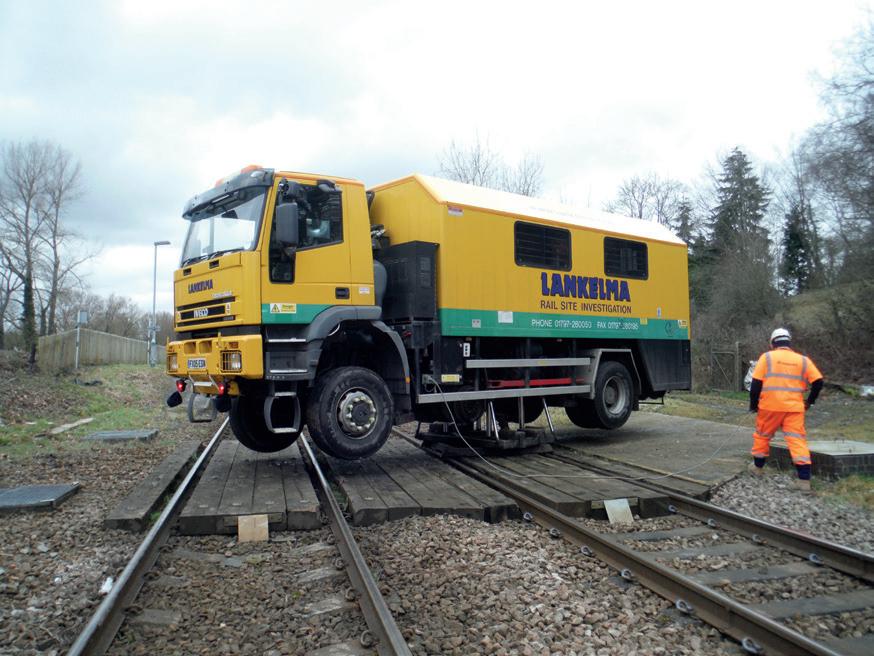
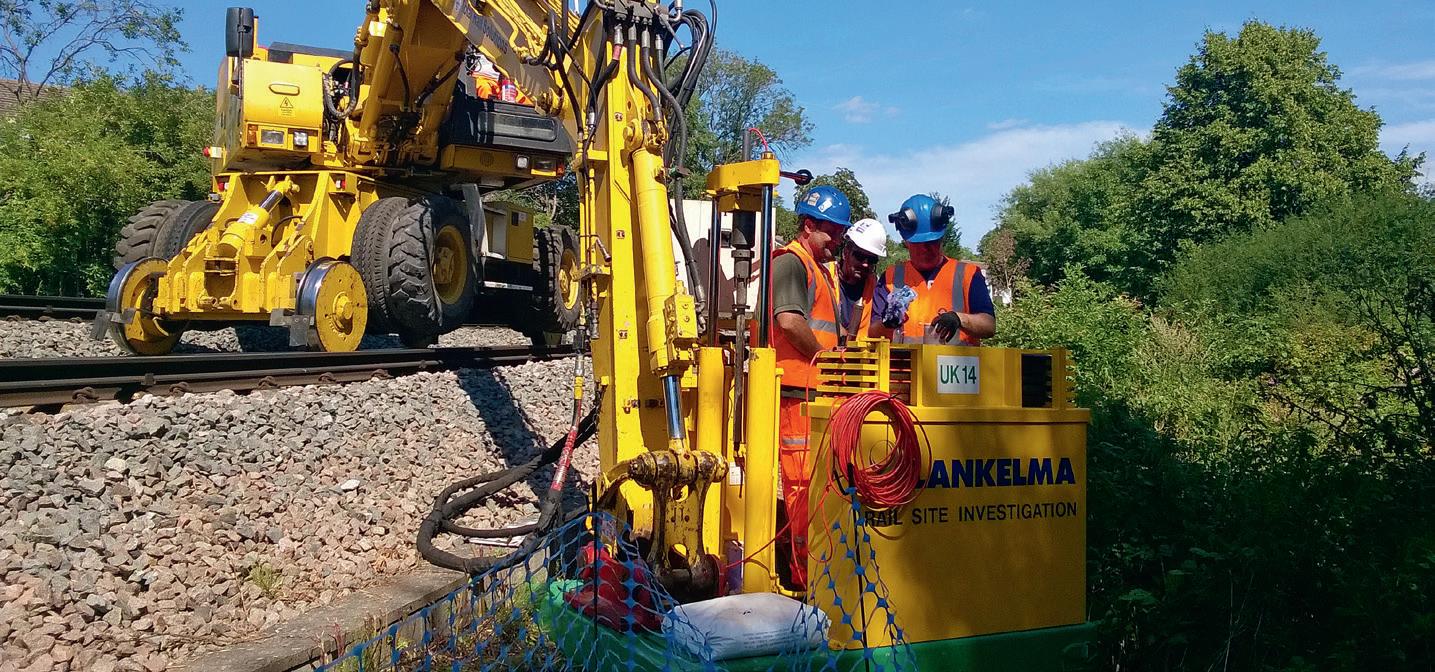

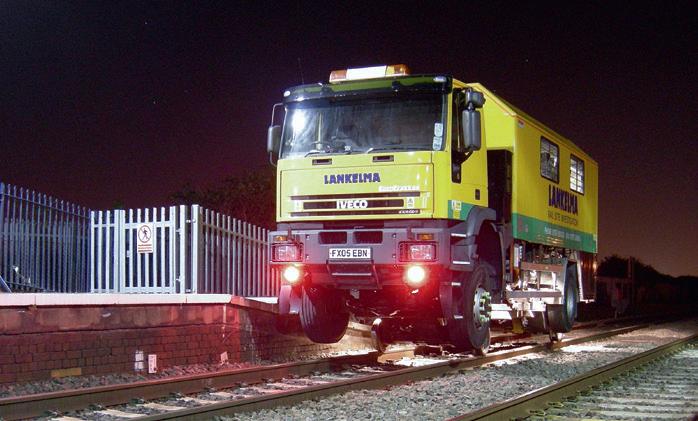
CONE PENETRATION TESTING (CPT) GEOTECHNICAL INSTALLATIONS Specialist site investigation for earthwork and track design Dedicated road-rail CPT trucks, RRV mounted CPT unit, and specialist CPT units Investigations in all areas of the trackway High production and cost effective investigations Quality results available in real-time Over 15 years working in the rail industry Experienced field operatives Rapid mobilisation
Programme (EGIP), delivered by Network Rail, involved modernisation and upgrades of key junctions, plus electrification of the rail network. Lankelma, working for ABC Electrification (a joint venture of Alstom, Babcock and Costain), carried out more than 250 CPTs to a maximum of twelve-metre depth in sands and soft, sensitive clays on the railway over 90 night shifts. Testing was carried out using Lankelma’s two rail units – rail CPT truck and excavator-mounted CPT unit. Geotechnical data was used directly in the design of foundations for the overhead line equipment support structures and for station remodelling along the route.
Following the identification of embankment instability on several rail assets in Hampshire and Somerset, Lankelma responded to the needs of an urgent requirement for geotechnical definition by delivering preliminary soil stratification, pore pressure and geotechnical parameter derivations within one week of completion. The rail CPT truck and excavator-mounted CPT unit carried out investigations at three sites over ten twelvehour shifts. As part of a scheme to improve London’s transport network, Lankelma were procured to carry out CPTs at Finsbury Park tube station. Using a lightweight mobile CPT unit anchored to the walls of the station’s stairwell, horizontal testing was performed. Four horizontal CPTs were pushed 14 metres into the wall to provide an assessment of the current structural arrangement.
Future plans/ambitions A rail track facility at Lankelma’s head office facilitates development of its rail-specific CPT units and maintenance of equipment. In-house mechanics ensure all rail plant is compliant with standards so they can offer a first-class service to clients.
Lankelma are RISQ accredited, trading as a specialist ‘plant hire’ company under Network Rail’s Plant Operator Scheme (POS), and all on-track rail plant are VAB approved. Lankelma have recently expanded their rail capabilities with a second track-mounted CPT unit. The latest addition is cutting edge technology and will assist to speed up rail investigations.
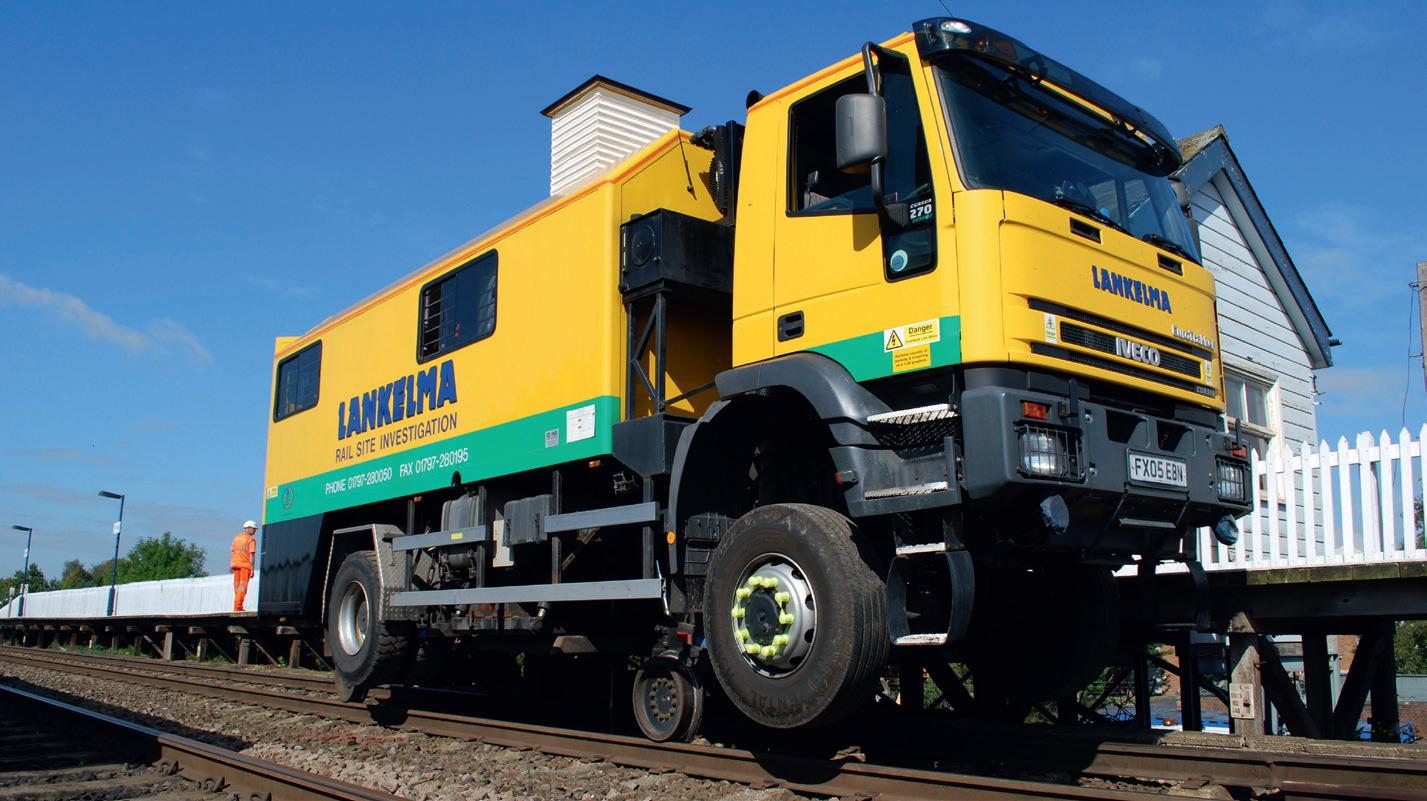
Tel: 01797 280 050 Email: info@lankelma.com Visit: www.lankelma.com
RAIL SITE INVESTIGATION

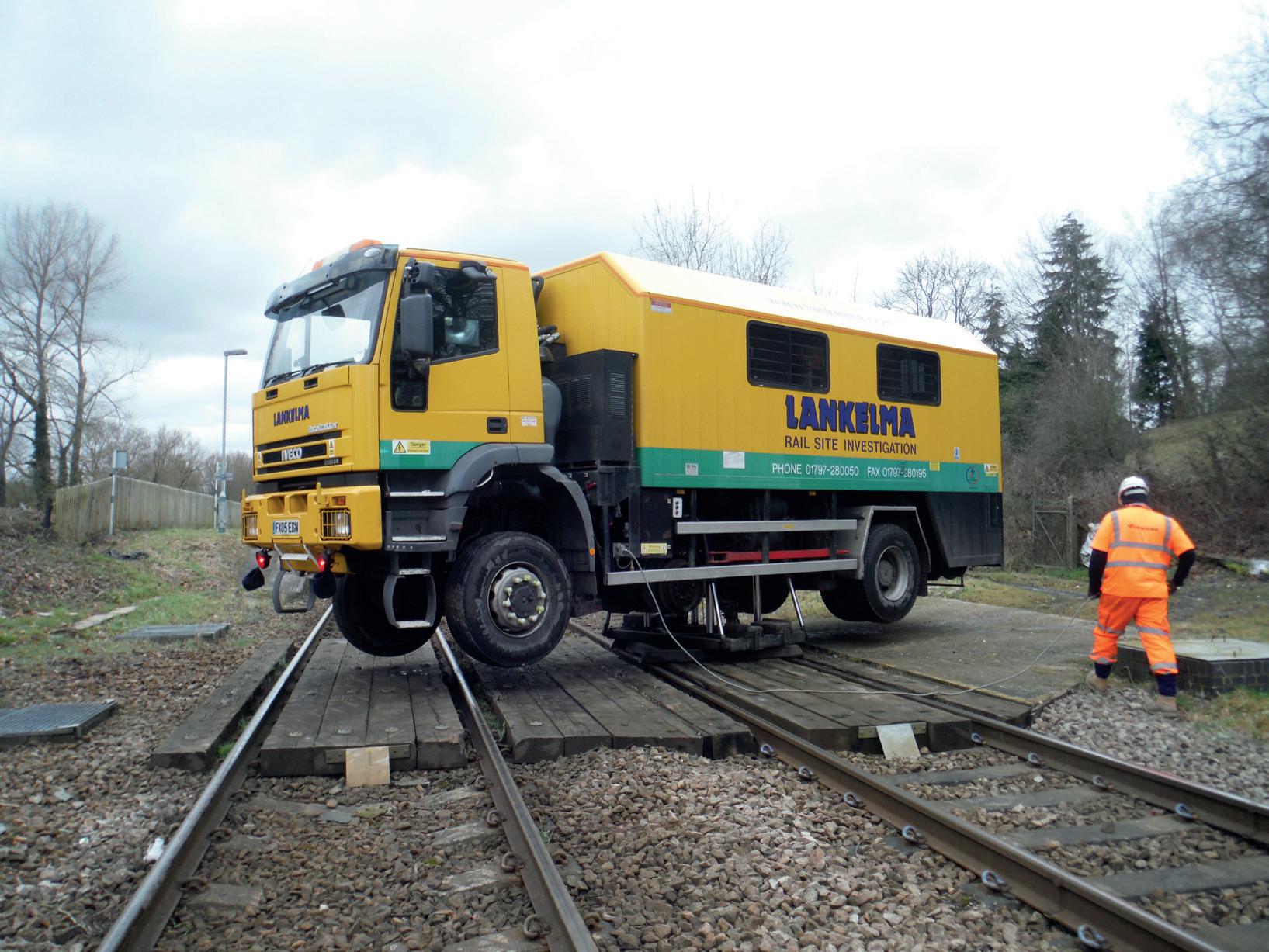

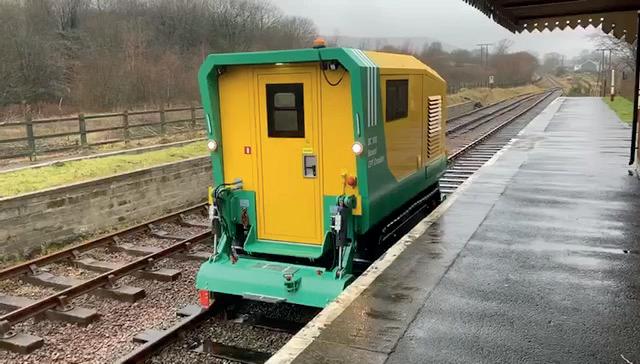
Contact us to discuss your rail investigation 01797 280050
Rail Professional
CPA Welcomes Stars of the Future Nominations from the Rail Plant Sector
Stars of the Future is the national awards scheme for plant occupation apprentices and trainees, organised by the CPA, the leading trade association for the plant-hire sector in the UK

The CPA has over 1,700 members who supply 85 per cent of hired plant to the construction industry and further administers the Rail Plant Association (RPA). Stars of the Future is now in ninth year and the awards programme is intended to recognise and reward outstanding plant occupation apprentices or trainees who not only bring ability and commitment to their learning and work, but also possess the extra capabilities which mark them out as potentially being the industry’s future leaders.
The CPA and RPA are welcoming nominations from the rail plant sector for the various categories of CPA Stars of the Future Apprentice and Trainee Awards for 2021. The headline sponsor for CPA Stars of the Future 2021 is Sunbelt Rentals UK.
The awards categories are aligned to and support the trailblazer-style apprenticeships and for the 2021 awards, comprise of: • Plant Mechanic of the Year (Level 2) sponsored by L Lynch Plant Hire. • Plant Technician of the Year (Level 3) sponsored by NOCN Group. • Plant Operative of the Year jointly sponsored by L Lynch Plant Hire and ACOP Group. • Lifting Technician of the Year sponsored by Liebherr. • Hire Controller of the Year sponsored by L
Lynch Plant Hire. • Plant Installer of the Year sponsored by L
Lynch Plant Hire. • College of the Year sponsored by Flannery
Plant Hire. • Best Personal Statement sponsored by
Wolffkran. • Judges’ Special Award sponsored by
Flannery Plant Hire.
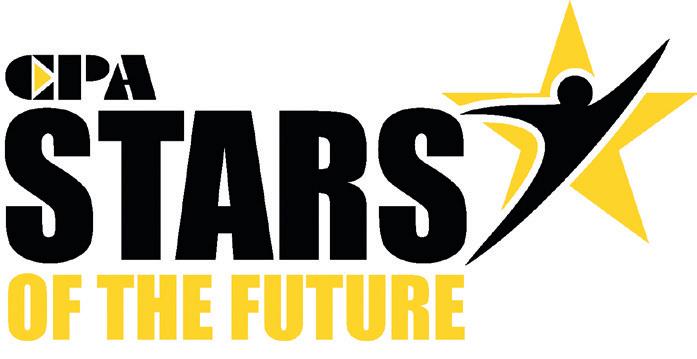
For the Plant Operative of the Year award, this is designed for those who operate at least two types of construction-based equipment, including RRVs, whilst for the Lifting Technician of the Year award, this is designed for someone who operates a mobile, crawler or tower crane and who further undertakes slinging and signalling duties.
Stars of the Future winners will be in contention for a number of prizes, as well as national recognition. Previous prizes have included Snap-on tool kits, iPads and an all-expenses paid trip to Germany to visit a Liebherr crane manufacturing plant.
To make a Star of the Future nomination, employers need to complete a nomination form to provide an account of their apprentice or trainee’s skills and attributes during the training period. It is used by the judging team to identify and reward the candidates who are deemed to be the most deserving for the various awards. There is also a section for the training provider and the nominee themselves to complete.
In order to qualify for a Star of the Future award, in essence, applicants need to be employed and working on one of the listed occupations at the appropriate level, on a recognised apprenticeship or formal training programme of a defined period for the occupation, working towards or holding a relevant NVQ, SVQ or another form of formal occupational competencebased qualification and on a formal training programme with off-the-job training. The specific criteria for each occupation is identified in the nomination form.
The judging for the awards is initially carried out by an internal CPA selection panel, followed by an external judging panel of independent industry experts who decide the eventual winners. As the judges have no prior knowledge of the nominees, they can only measure the nominee’s abilities and character through the information provided by the employer, training provider and the nominee themselves, so employers and providers are asked to be as thorough as possible on the nomination form. Employers do not need to be a CPA or RPA member to make a Stars nomination.
The nomination form covers criteria such as attitudes to health and safety, motivation and commitment, punctuality, potential for progression, inspiration to others, assessment results and academic planning and application.
The judges are particularly interested in identifying those candidates showing ambition, progression, and going the extra mile. Employers and training providers are encouraged to share why the candidate is being nominated, what makes them special, how they have contributed to the business they work for, what attributes they have shown to be recognised as a future leader, any hardships they may have encountered and any community work they have been involved in. Supporting testimonials from senior staff, co-workers, mentors or customers are particularly welcomed.
Nomination forms can be downloaded from the CPA website at www.cpa.uk.net and the nomination deadline is 31 May 2021. The winners will be announced at a physical, live awards ceremony on 14 September 2021 at the Heart of England Conference and Events Centre in Fillongley near Coventry.
Kevin Minton, Chief Executive of the CPA said: ‘Last year we had over 70 nominations for Stars of the Future and the standard of the entries was exceptional. We’re looking forward to receiving more great entries this year. Part of the nomination form allows nominees to make a statement – either written or by video and we find this is where candidates really stand out.
‘Video statements are especially welcomed as it gives candidates the opportunity to explain their apprenticeship journey, what motivates them, where they want to be and why. It makes a real difference to see a video coming from the candidate themselves, so we would urge all nominees to consider making a video statement as part of their nomination.
‘We appreciate that nominations can take quite some time to put together, so it’s best to start the process early and use the given time accordingly. We’d like to urge employers in the rail sector to nominate apprentices and trainees in their workforce who they believe should be recognised as stars in the making, to make sure they get the recognition they deserve’ Kevin continued.
For any queries relating to Stars of the Future and the nomination process, please email stars@cpa.uk.net or call 020 7796 3366.






WM Plant Hire recently deployed their specialist ‘Spider’ excavator alongside their long reach machines to assist critical emergency embankment repairs that closed the line between Tunbridge Wells and Tonbridge in Kent

Spider’ machine working on High Brooms cutting alongside the 22m long reach
Prolonged rainfall caused a landslip to occur at High Brooms picked up by remote monitoring sensors in the same area. Engineers were immediately despatched to investigate and assessed the risk leading to the line closure.
Fiona Taylor, Network Rail Route Director said: ‘It is essential that our railway is safe to travel on. We’ve had exceptionally wet conditions this winter driven by climate change and have suffered a number of landslips across the Southern region. This is a long-term challenge we’re facing and by taking another week to do this work, we can protect the line for generations to come.’
During the closure Network Rail managed to implement a permanent fix along the 160 year old cutting, which included regrading, soil nailing and netting to ensure no more slippage occurs. Over 5,000 tonnes of spoil were cleared and removed by train from the site. Calling in the ‘Spider’ Due to access restrictions to the site and overhead powerlines, the solution of using long reach excavators to reach the failed slope was not possible on one of the sections. Main contractor BAM Nuttall worked closely with their long-term specialist WM Plant Hire for the reach options and agreed on the Spider machine.
‘Being long reach specialists means we are constantly pushing the boundaries to solve problems. Specials like the 13 tonne Batemag Spider and 26 tonne CAT zero tail swing long reach are two such rare examples, perfect for difficult access and steep slopes where conventional machines don’t cut it’ says WM Plant Director Damian McGettrick.
Working directly on the slope the Spider excavator was coupled up with a safety line and began the task of clearing the material, placing it outside of the overhead risk zone for removal by the 22-metre long reach alongside. Fitted with a 360-degree tilt rotate unit allowed any angle to be achieved with any buckets or attachments. The individual hydraulic legs made it possible to position the excavator on steep slopes over 35 degrees with stability derived from the ‘spider’ legs. A high power to weight ratio provides hydraulic power more in keeping with 21 tonne class excavators.


A smaller long reach with rubber tracks operated from the toe of the slope while the ‘Spider’ worked directly on it, attached to a safety line Huw Jones BAM Nuttall’s Divisional Director, commented: ‘This work demonstrates the ingenuity, responsiveness and broadbased skillset of our team…working hand-in-hand with our rail supply chain partners, we were able to get the line open again less than three weeks after the slip was detected. I’d like to thank the whole team for its dedication and commitment to excellence over this period.’
For more information on the ‘Spider’ and other specialist long reach machines get in touch via the contact information below.
Tel: 01746 769555 Email: info@wmplanthire.com Visit: wmplanthire.com
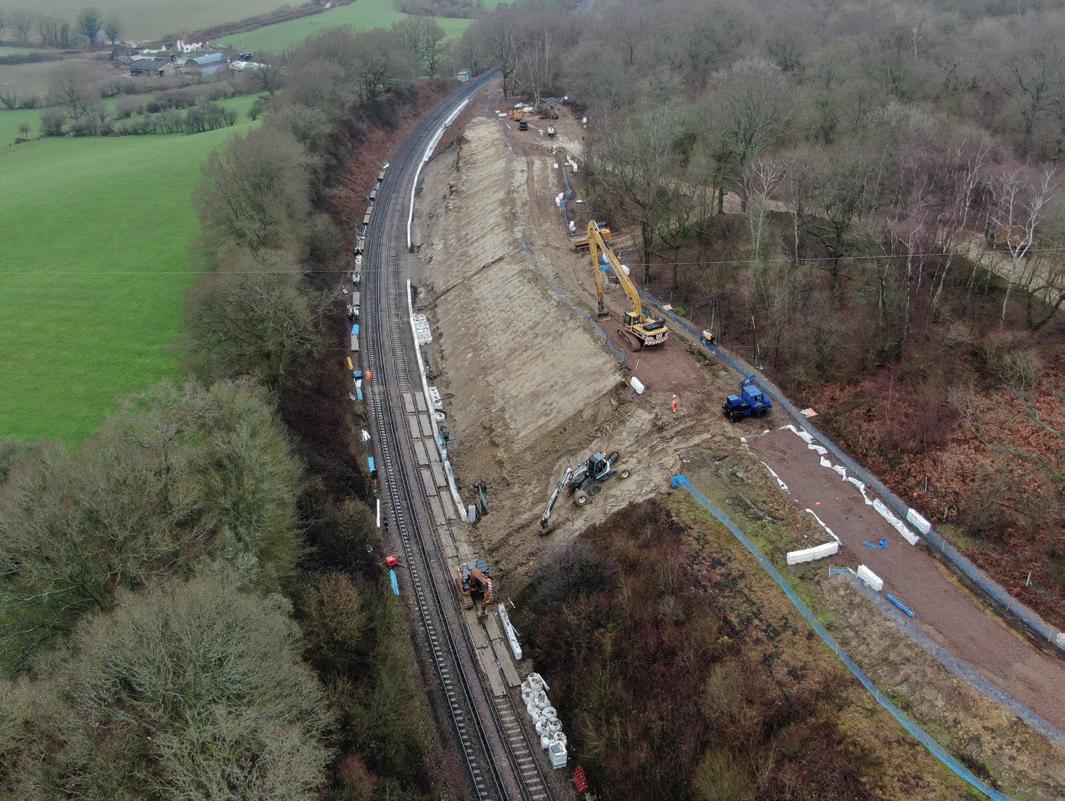
Overhead powerlines running over the site created an extra challenge for the repair











